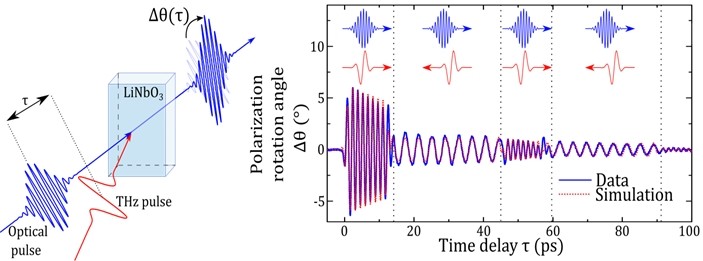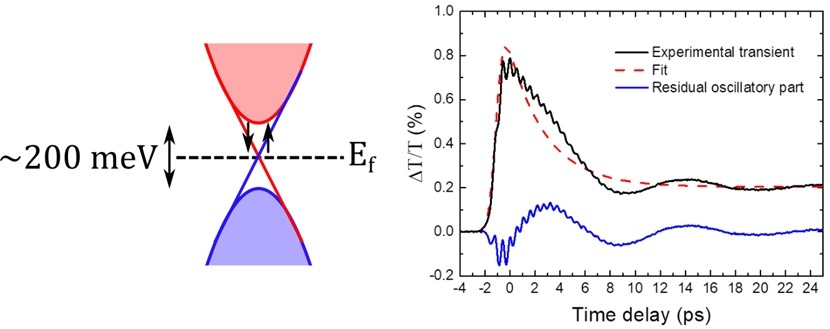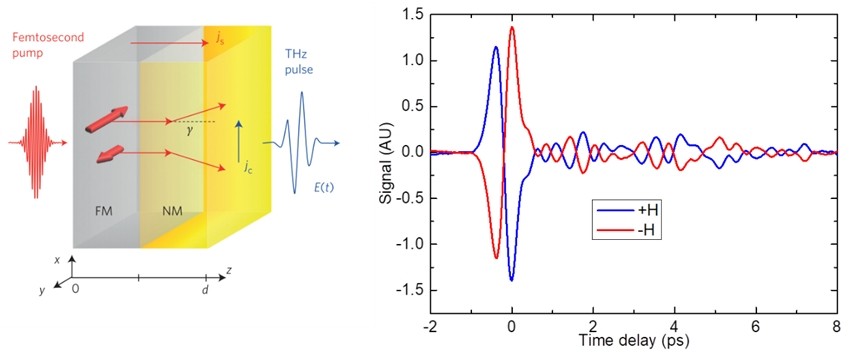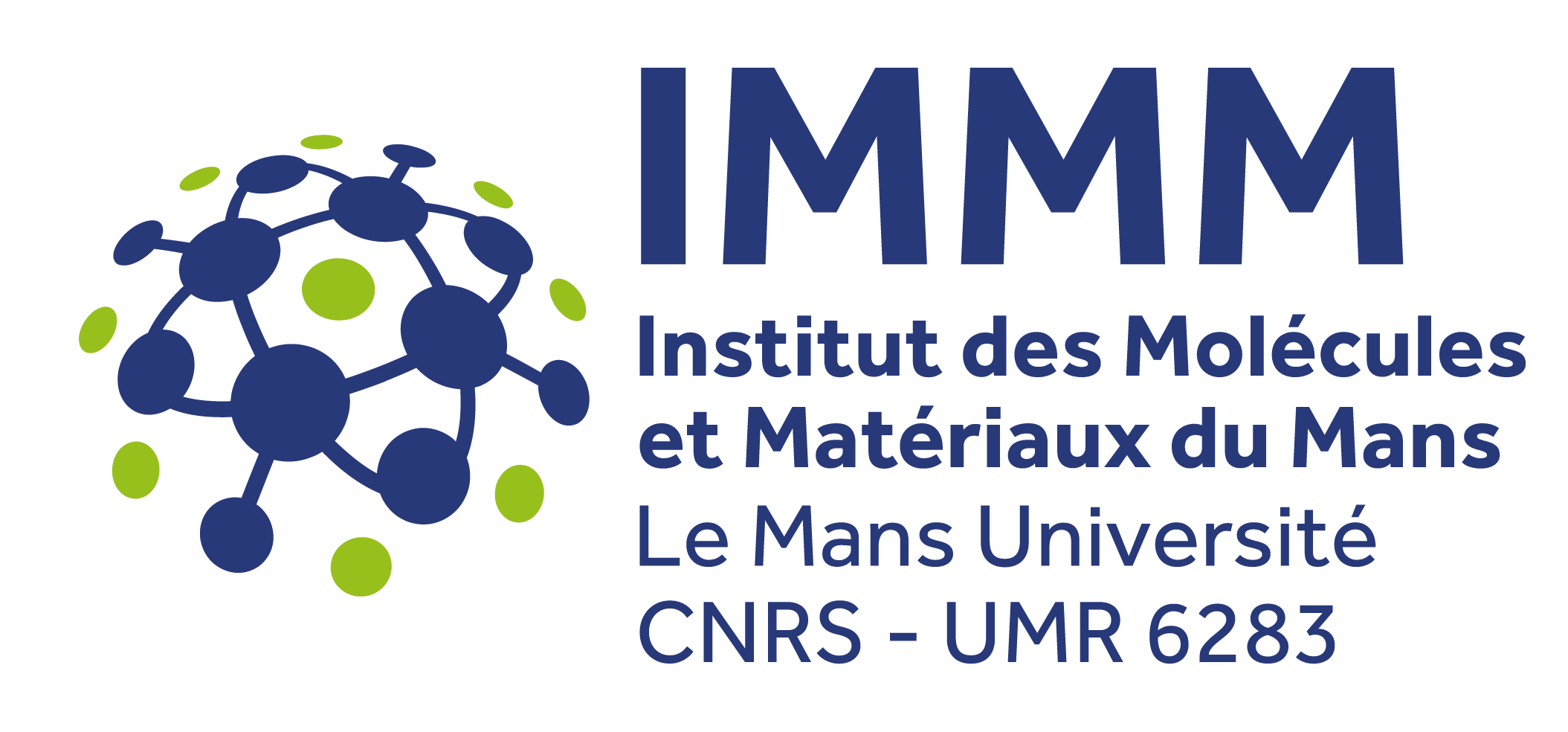Ultrafast terahertz spectroscopy

Ultrafast terahertz spectroscopy
Researchers
- Brice Arnaud
- Rémi Busselez
- Vincent Juvé
- Pascal Ruello
- Gwenaëlle Vaudel
- Mads Weber
- Coll. JY CHauleau, M. Viret, CEA-SPEC, J. Szade Institute of Physics Katowice (Poland), Laboratoire International Associé CNRS, France-Japon (LIA-IM-LED)
THz polarization modulation of visible light by THz pulses
Over the last decade, ultrafast Terahertz spectroscopy has gained tremendous attention thanks to the development of high-power ultrafast laser systems, which allowed generating intense single-cycle picosecond pulses of electric field at THz frequencies. Their relatively long optical cycle period (1 ps for 1 THz) and high electric field (from hundred of kV/cm to few MV/cm) provide a new tool for studying fundamental aspects of light-matter interactions. Field-resolved detection of ultra-short THz pulses is well known since many years and the most common technique is based on free-space electro-optic sampling. This leads to the polarization change of an optical pulse, which is detected by the polarization sensitive scheme, and to the field-resolved detection of a THz pulse. Here we evidenced efficient non-resonant and noncollinear χ(2)-type type light-matter interaction in femtoseconds polarization sensitive time-resolved optical measurements. Such nonlinear optical interaction of visible light and ultra-short THz pulses leads to THz modulation of visible light polarization in bulk LiNbO3 crystal. Theoretical simulations based on the wave propagation equation capture the physical processes underlying this nonlinear effect [1].
 Left: A femtosecond optical pulse and a THz pulse, delayed in time respect to each other, are overlapping in a LiNbO3 crystal. Right: Non-resonant and noncollinear χ(2)-type light-matter interaction leads to a rotation Δθ of the optical pulse polarization at THz frequencies
Left: A femtosecond optical pulse and a THz pulse, delayed in time respect to each other, are overlapping in a LiNbO3 crystal. Right: Non-resonant and noncollinear χ(2)-type light-matter interaction leads to a rotation Δθ of the optical pulse polarization at THz frequencies
Related papers
- [1] V. Juvé, G. Vaudel, Z. Ollmann, J. Hebling, V. Temnov, V. Gusev and T. Pezeril, Optics Letters 43 (2018)
Projects
- Région Pays de la Loire (Pari Scientifique NanoPlasmag 2018-2021)
- ANR SANTA 2018-2021
Ultrafast THz emission by spin to charge current conversion (ferroic materials and topological insulators)
Topological insulators (Bi2Se3, Bi2Te3 etc…) are a new class of material, which is stated to be at the core of the next generation of electronics devices. Their structure consists of a bulk small bandgap insulator together with spin polarized surface states, which can lead to surface spin current. Studying and controlling the surface spin current is of interest for the scientific community. Using ultrafast THz spectroscopy, with photon energy smaller than the band gap, one can try to have access to the surface states dynamics and, thus, to the spin dynamics. High quality samples, which are well characterized of Bi2Te3, are provided by the University of Silesia in Poland [1].
 Left: Simplified band structure of topological insulators, which consists of a combination of a small band gap together with spin-polarized Dirac cones. Right: Relative change of the transmission induced by a THz pulse (2 meV photon energy) measured with a 3.1 eV photon energy for a Bi2Te3 sample of 15nm thickness.
Left: Simplified band structure of topological insulators, which consists of a combination of a small band gap together with spin-polarized Dirac cones. Right: Relative change of the transmission induced by a THz pulse (2 meV photon energy) measured with a 3.1 eV photon energy for a Bi2Te3 sample of 15nm thickness.
We also have started to investigate the emerging field related to spin-to-chareg conversion (vice-versa). spin bursts can be produced by direct excitation of hot electrons in a ferromagnetic layer triggered by a femtosecond laser pulse. During the relaxation processes the diffusion lifetime and mobility differ for majority and minority spin carriers, resulting in the emission of angular momentum on a timescale of picoseconds. This effect, combined with Inverse Spin Hall Effect in an adjacent non-magnetic layer (Pt), was recently used to make efficient THz generation devices [2]. Based on this principle, we have already carried out preliminary measurement with CoFeB on Pt by shining femtosecond laser pulses to inject spin current bursts. As the direction of spin current is determined by the magnetization of the Ferromagnetic, the mechanism provides an easy and efficient way of controlling the direction of spin torque with a small magnetic field. This project is part of the Santa ANR (2018-2021) lead by Michel Viret (CEA/SPEC) within which IMMM is involved (starting Oct 2018).
 Left: Principle of the spin to charge current conversion leading to THz emission (taken from Seifert et al Nat. Phot. 2016). Right: Ultrafast THz emission measured by electro-optic sampling after ultrafast photoexcitation in a FeCoB(5nm)/Pt(3nm) sample. Reversing the external magnetic field leads to a change of sign of the THz electric field.
Left: Principle of the spin to charge current conversion leading to THz emission (taken from Seifert et al Nat. Phot. 2016). Right: Ultrafast THz emission measured by electro-optic sampling after ultrafast photoexcitation in a FeCoB(5nm)/Pt(3nm) sample. Reversing the external magnetic field leads to a change of sign of the THz electric field.
Related papers
-
Pump wavelength-dependent terahertz spin-to-charge conversion in CoFeB/MgO Rashba interface, Artem Levchuk, Vincent Juvé, Tadele Orbula Otomalo, Théophile Chirac, Olivier Rousseau, Aurélie Solignac, Gwenaëlle Vaudel, Pascal Ruello, Jean-Yves Chauleau, Michel Viret, Applied Physics Letters 123 (1) (2023)
-
Coherent acoustic phonons generated by ultrashort terahertz pulses in nanofilms of metals and topological insulators
A Levchuk, B Wilk, G Vaudel, F Labbé, B Arnaud, K Balin, J Szade, P Ruello, V Juvé
Physical Review B 101 (18), 180102 (2020) - [1] V. Juvé et al, in preparation
- [2] T. S. Seifert, N. M. Tran, O. Gueckstock, S. M. Rouzegar, L. Nadvornik, S. Jaiswal, G. Jakob, V. V. Temnov, M. Münzenberg, M. Wolf, M. Kläui and T. Kampfrath. J. Phys. D Appl. Phys. (2018)
Projects
- Région Pays de la Loire (Pari Scientifique NanoPlasmag 2018-2021)
- ANR SANTA 2018-2021







